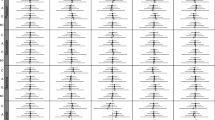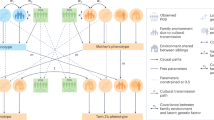Abstract
Twin studies compare the similarity between monozygotic twins to that between dizygotic twins in order to investigate the relative contributions of latent genetic and environmental factors influencing a phenotype. Statistical methods for twin data include likelihood estimation and Defries–Fulker regression. We propose a new generalization of the Defries–Fulker model that fully incorporates the effects of observed covariates on both members of a twin pair and is robust to violations of the Normality assumption. A simulation study demonstrates that the method is competitive with likelihood analysis. The Defries–Fulker strategy yields new insight into the parameter space of the twin model and provides a novel, prediction-based interpretation of twin study results that unifies continuous and binary traits. Due to the simplicity of its structure, extensions of the model have the potential to encompass generalized linear models, censored and truncated data; and gene by environment interactions.



Similar content being viewed by others
References
Allison DB, Neale MC, Zannolli R, Schork NJ, Amos CI, Blangero J (1999) Testing the robustness of the likelihood-ratio test in a variance-component quantitative-trait loci–mapping procedure. Am J Hum Genet 65:531–544
Angst MS, Phillips NG, Drover DR, Tingle M, Galinkin JL, Christians U, Swan GE, Lazzeroni LC, Clark JD (2010) Opioid pharmacogenomics using a twin study paradigm: methods and procedures for determining familial aggregation and heritability. Twin Res Hum Genet 13(5):412–425
Angst MS, Lazzeroni LC, Phillips NG, Drover DR, Tingle M, Ray A, Swan GE, Clark JD (2012a) Aversive and reinforcing opioid effects: a pharmacogenetic twin study. Anesthesiology 117(1):22–37
Angst MS, Phillips NG, Drover DR, Tingle M, Ray A, Swan GE, Lazzeroni LC, Clark JK (2012b) Pain sensitivity and opioid analgesia: a pharmacogenetic twin study. Pain 153(7):1397–1409
Bhandari V, Bizzaro MJ, Shetty A, Zhong X, Grier PP, Zhang H, Ment LR (2006) Familial and genetic susceptibility to major neonatal morbidities in preterm twins. Pediatrics 117(6):1901–1906
Boomsma D, Busjahn A, Peltonen L (2002) Classical twin studies and beyond. Nat Rev Genet 3:872–882
Carey G (2005) Cholesky problems. Behav Genet 35(5):653–665
Castillo E, Galambos J (1989) Conditional distributions and the bivariate normal distribution. Metrika 36(1):209–214
Cherny SS, Defries JC, Fulker DW (1992) Multiple regression analysis of twin data: a model-fitting approach. Behav Genet 22(4):489–497
Defries JC, Fulker DW (1985) Multiple regression analysis of twin data. Behav Genet 15(5):467–473
Feng R, Zhou G, Zhang H (2009) Analysis of twin data using SAS. Biometrics 65(2):584–589
Fisher RA (1918) The correlation between relatives on the supposition of Mendelian inheritance. Philos Trans Royal Soc Edinb 52:399–433
Friedman MC, Chhabildas N, Budhiraja N, Willcutt EG, Pennington BF (2003) Etiology of the comorbidity between RD and ADHD: exploration of the non-random mating hypothesis. Am J Med Genet 120B(1):109–115
Galton F (1875) The history of twins, as a criterion of the relative powers of nature and nurture. Fraser’s Mag 12:566–576
Hannah MC, Hopper J, Mathews J (1985) Twin concordance for a binary trait. II. Nested analysis of ever-smoking and ex-smoking traits and unnested analysis of a “committed-smoking” trait. Am J Hum Genet 37(1):153–165
Haseman JK, Elston RC (1970) The estimation of genetic variance from twin data. Behav Genet 1(1):11–19
Hettema JM, Neale MC, Kendler KS (1995) Physical similarity and the equal-environment assumption in twin studies of psychiatric disorders. Behav Genet 25(4):327–335
Hicks BM, Krueger RF, Iacono WG, McGue M, Patrick CJ (2004) Family transmission and heritability of externalizing disorders: a twin-family study. Arch Gen Psychiatry 61(9):922–928
Karlin S, Cameron EC, Chakraborty R (1983) Path analysis in genetic epidemiology: a critique. Am J Hum Genet 35:695–732
Keller MC, Coventry WL (2005) Quantifying and addressing parameter indeterminacy in the classical twin design. Twin Res Hum Genet 8:201–213
Kempthorne O, Osborne RH (1961) The interpretation of twin data. Am J Hum Genet 13(3):320–339
Kendler KS (1993) A test of the equal environment assumption in twin studies of psychiatric illness. Behav Genet 23:21–27
Kohler H, Rodgers JL (1999) DF-like analyses of binary, ordered, and censored variables using probit and tobit approaches. Behav Genet 29(4):221–232
Kohler H, Rodgers JL (2001) DF-analyses of heritability with double-entry twin data: asymptotic standard errors and efficient estimation. Behav Genet 31(2):179–191
Laird NM, Ware JH (1982) Random-effects models for longitudinal data. Biometrics 38:963–974
MacGregor AJ, Antoniades L, Matson M, Andrew T, Spector TD (2000) The genetic contribution to radiographic hip osteoarthritis in women: results of a classic twin study. Arthritis Rheum 43(11):2410–2416
Manolio T, Collins FS, Cox NJ, Goldstein DB, Hindorff LA, Hunter DJ, McCarthy MI et al (2009) Finding the missing heritability of complex diseases. Nature 461:747–753
Martin NG, Eaves LJ (1977) The genetical analysis of covariance structure. Heredity 38:79–95
Martin NG, Eaves LJ, Heath AC, Jardine R, Feingold LM, Eysenck HJ (1986) Transmission of social attitudes. Proc Natl Acad Sci 83(12):4364–4368
Neale MC (1997) Mx: statistical modeling, 2nd edn. Department of Psychiatry, Medical College of Virginia, Richmond
Neale M, Cardon L (1992) Methodology for genetic studies of twins and families. Kluwer Academic, Dordrecht
Purcell S (2002) Variance components models for gene-environment interaction in twin analysis. Twin Res 5(6):554–571
Purcell S, Sham PC (2003) A model-fitting implementation of the Defries–Fulker model for selected twin data. Behav Genet 33:271–278
Rabe-Hesketh S, Skrondal A, Gjessing HK (2008) Biometrical modeling of twin and family data using standard mixed model software. Biometrics 64(1):280–288
Rijsdijk FV, Sham PC (2002) Analytic approaches to twin data using structural equation models. Brief Bioinform 3(2):119–133
Risch N (1990) Linkage strategies for genetically complex traits. II. The power of affected relative pairs. Am J Hum Genet 46:229–241
Rodgers JL, Kohler HP (2005) Reformulating and simplifying the DF analysis model. Behav Genet 35(2):211–217
Rodgers JL, McGue M (1994) A simple algebraic demonstration of the validity of Defries–Fulker analysis in unselected samples with multiple kinship levels. Behav Genet 24(3):259–262
Rodgers JL, Rowe DC, May K (1994) DF analysis of NLSY IQ/achievement data: nonshared environmental influences. Intelligence 19:157–177
Rodgers JL, Buster M, Rowe DC (2001) Genetic and environmental influences on delinquency: DF analysis of NLSY kinship data. J Quant Criminol 17:145–168
Ruau D, Dudley JT, Chen R, Phillips NG, Swan GE, Lazzeroni LC, Clark JD, Butte AJ, Angst MS (2012) Integrative approach to pain genetics identifies pain sensitivity loci across diseases. PLoS Comput Biol 8(6):e1002538
Schafer DW (1987) Covariate measurement error in generalized linear models. Biometrika 74(2):385–391
Self SG, Liang KY (1987) Asymptotic properties of maximum likelihood estimators and likelihood ratio tests under nonstandard conditions. J Am Stat Assoc 82(398):605–610
Sham PC, Walters EE, Neale M, Heath AC, MacLean CJ, Kendler KS (1994) Logistic regression analysis of twin data: estimation of parameters of the multifactorial liability-threshold model. Behav Genet 24:229–238
StataCorp (2009) Stata statistical software: release 11. StataCorp LP, College Station
Stata Press (2009) Stata user’s guide: release 11. StataCorp LP, College Station
Stefanski LA, Carroll RJ (1985) Covariate measurement error in logistic regression. Ann Stat 13:1335–1351
Stoel R, Garre FG, Dolan C, Wittenboer GV (2006) On the likelihood ratio test in structural equation modeling when parameters are subject to boundary constraints. Psychol Methods 11(4):439–455
Sullivan PF, Eaves LJ (2002) Evaluation of analyses of univariate discrete twin data. Behav Genet 32(3):221–227
Visscher PM (2006) A note on the asymptotic distribution of likelihood ratio tests to test variance components. Twin Res Hum Genet 9(4):490–495
Visscher PM, Hill WG, Wray NR (2008) Heritability in the genomics era–concepts and misconceptions. Nat Rev Genet 9:255–266
Waller NB (1994) A Defries and Fulker regression model for genetic nonadditivity. Behav Genet 24(2):149–153
Williams CJ (1993) On the covariance between parameter estimates in models of twin data. Biometrics 49:557–568
Williams CJ, Christain JC, Norton JA (1992) TWINAN90: a FORTRAN program for conducting ANOVA-based and likelihood-based analyses of twin data. Comput Methods Programs Biomed 38:167–176
Wright S (1921) Correlation and causation. J Agric Res 20:557–585
Young SE, Stallings MC, Corley RP, Krauter KS, Hewitt JK (2000) Genetic and environmental influences on behavioral disinhibition. Am J Med Genet 96(5):684–695
Acknowledgments
The authors thank Drs. Heping Zhang and Vineet Bhandari for access to the BPD data. We also thank Joe Rodgers and an anonymous reviewer for many helpful suggestions. This work was supported by NIH grants R01MH086135, R01DA023063 and R01MH083972 and the Clinical Science Research & Development Service of the Department of Veterans Affairs (A Cooperative Studies Program-Wide DNA Bank, CSP#478).
Conflict of interest
The authors have no conflicts of interest to declare.
Author information
Authors and Affiliations
Corresponding author
Additional information
Edited by Stacey Cherny
Rights and permissions
About this article
Cite this article
Lazzeroni, L.C., Ray, A. A Generalized Defries–Fulker Regression Framework for the Analysis of Twin Data. Behav Genet 43, 85–96 (2013). https://doi.org/10.1007/s10519-012-9573-7
Received:
Accepted:
Published:
Issue Date:
DOI: https://doi.org/10.1007/s10519-012-9573-7




